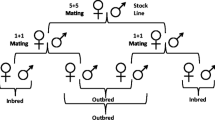Summary
It has been demonstrated that a well-defined population ofDermestes vulpinus, consisting of a few thousand members caught from a pile of sheepskins was mating at random, by means of testing the ratio of homozygous to heterozygous animals for a wing and a body-colour factor, for which the species is polymorphic.
Mice inbred from a population in a Scottish coal-mine, comprising the types yellow-belly and grey-belly, revealed an unexpected lack of heterozygotes. It was concluded that the mice were not mating at random, but break up into comparatively small mating units. This was corroborated by the fact that mice tested for heterozygosis for hidden recessives failed to segregate for any.
From Dubinin’s data it was concluded that there is no evidence for inbreeding inDrosophila melanogaster.
Similar content being viewed by others
References
Barrett-Hamilton, G. E. H. (1910).A History of British Mammals. London; Gurney and Jackson.
Castle, H. E. (1914). “Some new varieties of rats and guinea-pigs and their relation to problems of colour-inheritance.”Amer. Nat. 48.
Crew, F. A. E. &Mirskaja, L. (1932). “The character ‘hairless’ in the mouse.”J. Genet. 25.
Dobzhansky, Th. (1937).Genetics and the Origin of Species. Columbia Univ. Press.
Dubinin, N. P. & fourteen collaborators (1934). “Experimental studies of the ecogenotypes ofDrosophila melanogaster.”Biol. Zh., Mosk.,3.
Dubinin, N. P.,Heptner, M. A.,Demidara, Z. A. &Djackkova, L. J. (1936). “Genetic constitution and gene dynamics of wild populations ofDrosophila melanogaster.”Biol. Zh., Mosk.,5.
Dubinin, N. P. &Romašov, D. D. (1932). “Die genetische struktur der Art und ihre Evolution.”Biol. Zh., Mosk.,1.
Dubinin, N. P.,Romašov, D. D.,Heptner, M. A. &Demidova, Z. A. (1937). “Aberrant polymorphism inDrosophila fasciata Meig. (syn.melanogaster Meig.).”Biol. Zh., Mosk.,6.
Dunn, L. C. (1928). “A fifth allelomorph in the agouti series of the house mouse.”Proc. nat. Acad. Sci., Wash.,14.
Elton, C. (1924). “Periodic fluctuation in numbers of animals, their causes and effects.”Brit. J. exp. Biol. 2.
—— (1933).The Ecology of Animals. London: Methuen and Co.
Elton, C. (1936). “House mice (Mus musculus) in a coal-mine in Ayrshire.”Ann. Mag. nat. Hist. (10),xvii.
Fisher, R. A. (1930).Genetical Theory of Natural Selection. Oxford: Clarendon Press.
Gordon, C. (1936). “The frequency of heterozygosis in free-living populations ofDrosophila melanogaster andDrosophila sub-obscura.”J. Genet. 33.
Haldane, J. B. S. (1932).Causes of Evolution. New York and London: Harper and Bell.
-- (1938). “Indirect evidence for mating systems in natural populations.”J. Genet. 23.
Jenkins, F. J. (1930).Enforced Inbreeding of some Plant Species. Welsh Plant Breeding Station.
Keeler, C. E. (1931).The Laboratory Mouse, its Origin, Heredity and Culture. Harvard Univ. Press.
Lloyd, R. E. (1912).The Growth of Groups in the Animal Kingdom. Longmans, Green and Co.
Snell, G. (1931). “Inheritance in the house mouse, the linkage relations of short ear, hairless and naked.”Genetics,16.
Wright, S. (1921). “Systems of mating.”Genetics,6.
-- (1932). “The roles of mutation, inbreeding, cross-breeding and selection in evolution.”Proc. VIth Genet. Congr.
Rights and permissions
About this article
Cite this article
Philip, U. Mating systems in wild populations ofDermestes vulpinus andMus musculus . Journ. of Genetics 36, 197–211 (1938). https://doi.org/10.1007/BF02982414
Issue Date:
DOI: https://doi.org/10.1007/BF02982414




